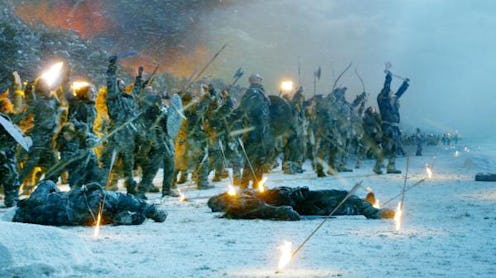Entertainment
How The 'GoT' Battle Actually Went Down

I know I wasn't the only fan who was expecting to find out whether Tyrion lived or died in Sunday night's Game of Thrones episode and was disappointed when, instead, we got an hour filled with nothing but warfare on the Wall. Well, maybe not disappointed — sure, it wasn't the King's Landing drama I was hoping for, but the battle was one of the coolest Thrones has shown so far. From that first shot of the Night's Watch men looking down at the approaching forces to all those arrows shot by Ygritte (R.I.P.) flying in mid-air to, um, that mammoth, "The Watchers on the Wall" was one of the most exciting and visually stunning episodes of Thrones to ever air.
Not to mention the most expensive. In an interview with Vulture, Thrones director Neil Marshall didn't reveal exact figures, but implied that Sunday's episode cost more to shoot than season two's "Blackwater" ($8 million) and could potentially have cost as much as $12 million. Considering all the astounding effects that went into the hour, a budget that large makes sense, but it's still hard to wrap our heads around the fact that 60 minutes of TV could cost more than most indie movies.
So let's break it down — where, exactly, did all that money go?
1. The Extras
Between 100 and 200 of them, to be exact. That's a whole lot of people to pay, although we're sure most of them would've happily taken cameos on Thrones for free.
2. The Giants
No, not creating them on a computer — those so-huge-they-make-the-Mountain-look-small men you saw attacking the Wall were played by real actors, albeit 7'5" and 8'0" tall ones who were then doubled in size by a (very expensive) computer.
3. The Mammoth
100 percent CGI, so animal lovers can breathe a sigh of relief: no overly large elephants were harmed in the making of Sunday's Thrones.
4. The Giant Riding the Mammoth
And here's where it gets complicated. To show the (real) giant riding the (fake) mammoth, Thrones filmed the man riding a mechanical bull against a green-screen so that they could capture his motions, and then later replaced the bull with the CGI-ed mammoth. Said Marshall, "it sounds quite simple but it’s really logistically time consuming."
5. The Wall
As much as Thrones fans would like to believe otherwise, there really isn't a massive, miles-long wall located somewhere in Ireland. There are a few small segments of the wall, however, as background part of different sets. "Everything else is fabricated, CG, or matte paintings," said Marshall.
For Sunday's episode, the show had to build an entirely new set on top of the wall, complete with "the biggest backdrop in Europe." It's over 100 feet tall, and building it was dangerous, thanks to issues like ice trenches. But it was all worth it, said Marshall, because "it looked spectacular!"
6. That Uninterrupted Shot
You know the one: about 40 minutes into the episode, Jon Snow comes down from the wall and viewers see all the fighting around the castle, in an unbelievable 360-degree shot. To make that happen, the crew spun a camera on a crane around "with such speed that "if it had hit somebody it could have killed them," and did that for seven uninterrupted takes. To ensure that everyone was ready, they split the actors into numbered sections, and when the crew called out a number, each team would start their action.
7. Those Arrows
Shooting an arrow at someone 10 feet away? So season three Game of Thrones. Sunday's episode took archery to a whole new level, such as when one of the giants shot an arrow into the air and hit a man standing on the Wall, who then fell over the other side and crashed spectacularly into the ground. For that sequence, the Thrones crew shot the scene in three different locations: a field in front of a green screen for the giant, on set for the Wall guy, and Castle Black for when he landed.
8. That Scythe
By far, the coolest moment of the battle was the scythe that came flying down the Wall and completely demolished the Wildlings in its path. Although the blade was CGI-ed, parts of the weapon's chain were real, which, at that size, must've cost the show a fortune. Marshall revealed that Thrones' showrunners were pressured to take the scythe out, but after some fighting, they were allowed to keep it in. Because really, what kind of battle is complete without a giant weapon killing a half-dozen people in one single stroke?
Images: HBO